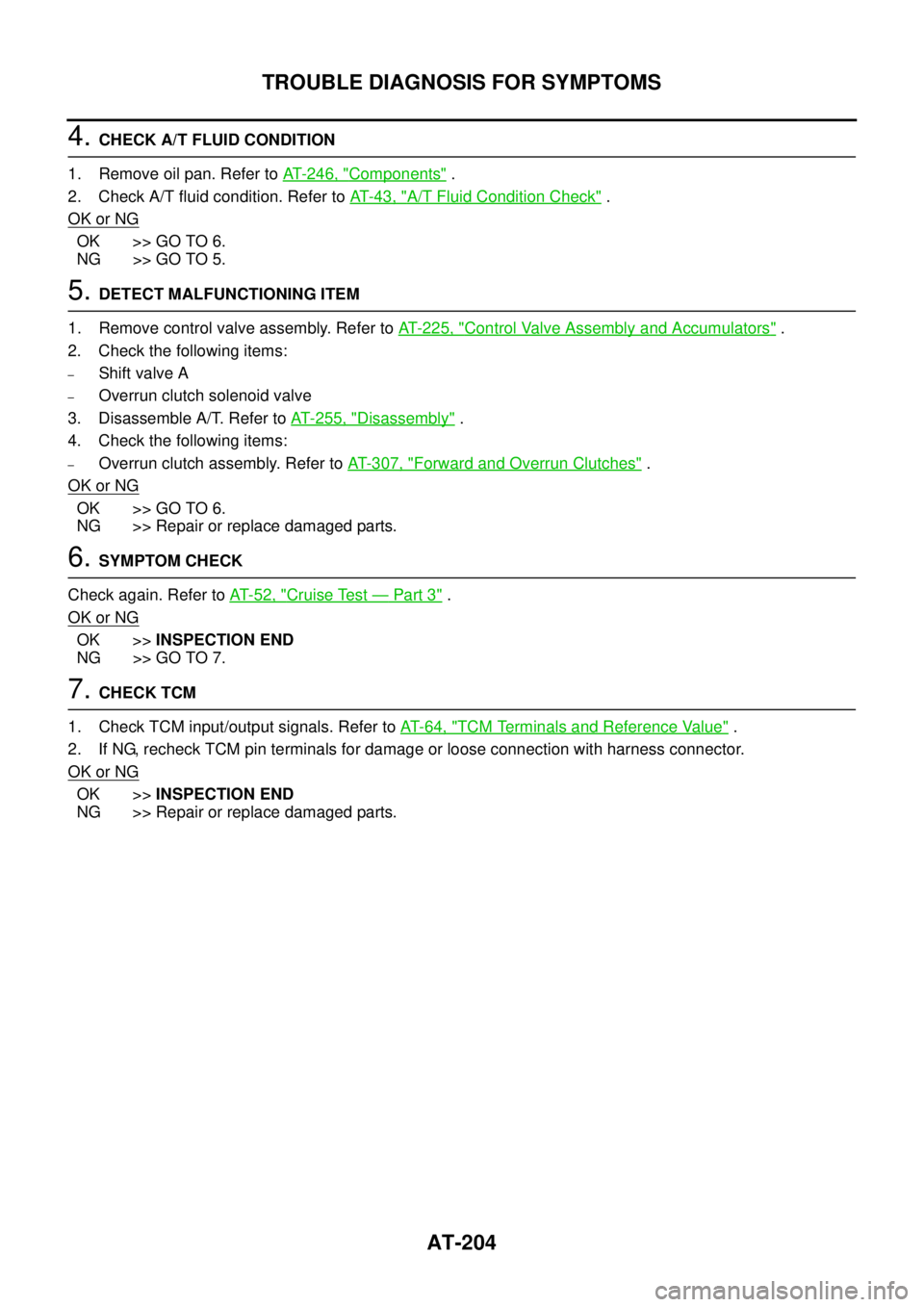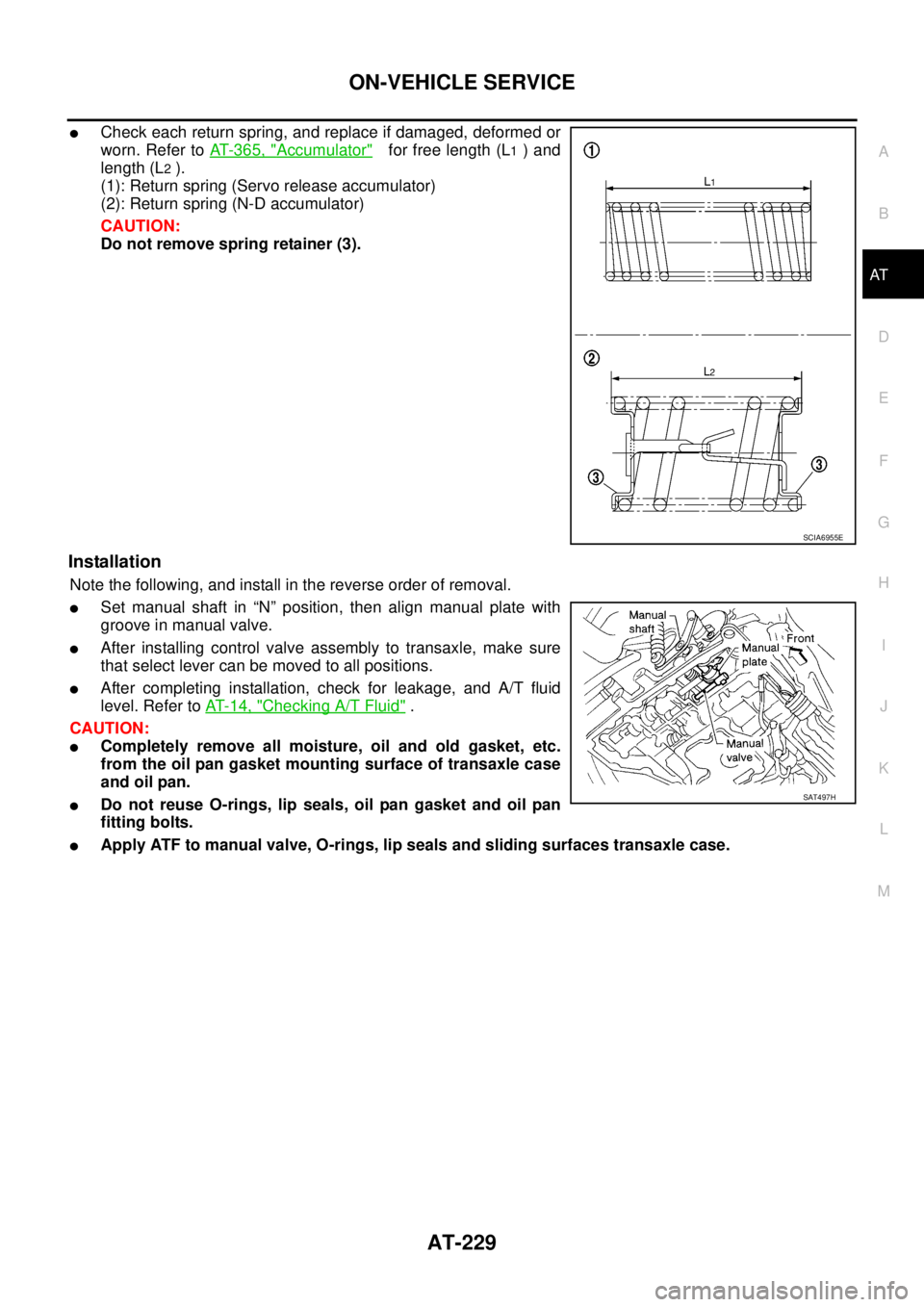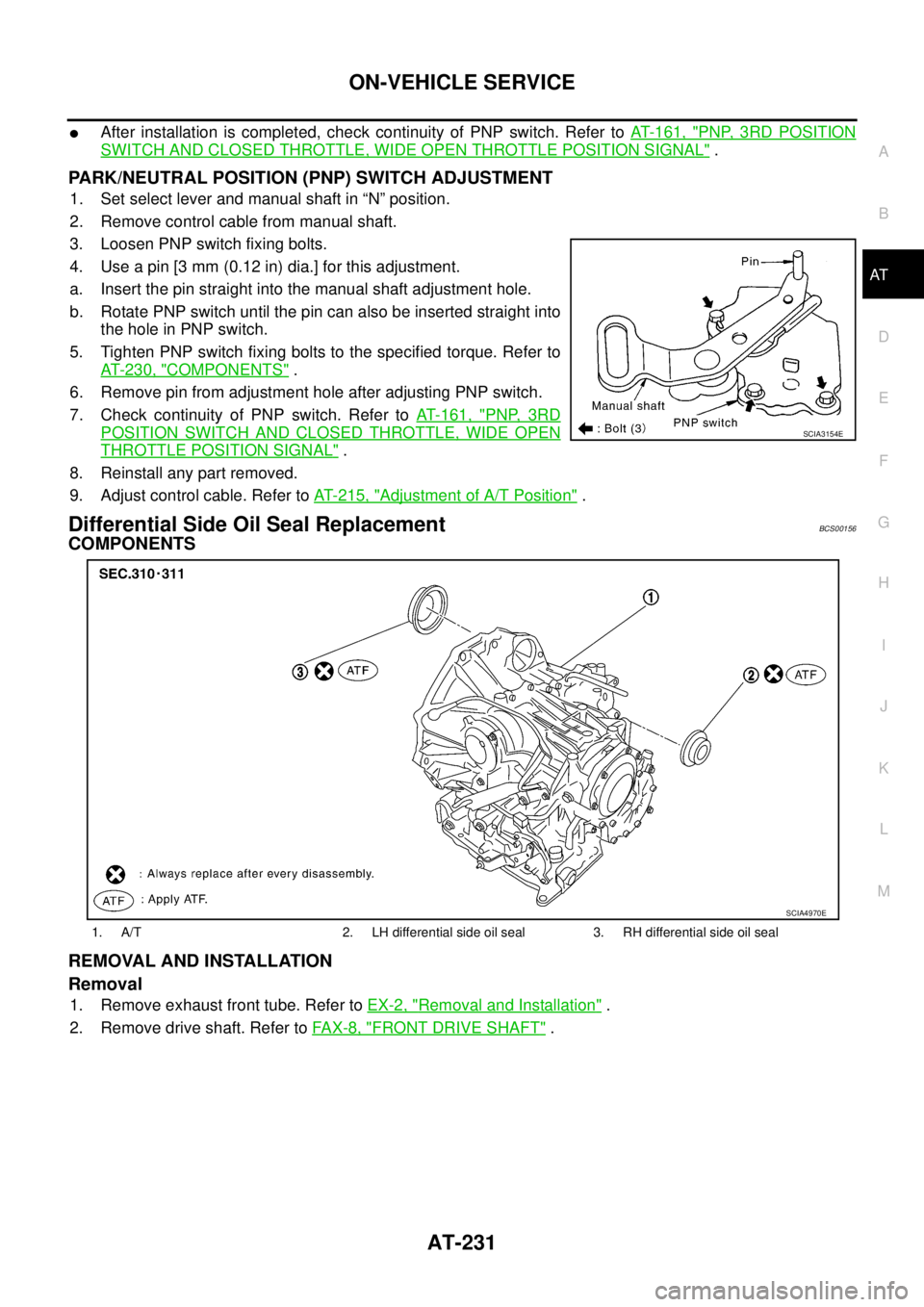Page 212 of 3502

AT-204
TROUBLE DIAGNOSIS FOR SYMPTOMS
4. CHECK A/T FLUID CONDITION
1. Remove oil pan. Refer to AT- 2 4 6 , "
Components" .
2. Check A/T fluid condition. Refer to AT- 4 3 , "
A/T Fluid Condition Check" .
OK or NG
OK >> GO TO 6.
NG >> GO TO 5.
5. DETECT MALFUNCTIONING ITEM
1. Remove control valve assembly. Refer to AT- 2 2 5 , "
Control Valve Assembly and Accumulators" .
2. Check the following items:
–Shift valve A
–Overrun clutch solenoid valve
3. Disassemble A/T. Refer to AT- 2 5 5 , "
Disassembly" .
4. Check the following items:
–Overrun clutch assembly. Refer to AT- 3 0 7 , "Forward and Overrun Clutches" .
OK or NG
OK >> GO TO 6.
NG >> Repair or replace damaged parts.
6. SYMPTOM CHECK
Check again. Refer to AT- 5 2 , "
Cruise Test — Part 3" .
OK or NG
OK >>INSPECTION END
NG >> GO TO 7.
7. CHECK TCM
1. Check TCM input/output signals. Refer to AT- 6 4 , "
TCM Terminals and Reference Value" .
2. If NG, recheck TCM pin terminals for damage or loose connection with harness connector.
OK or NG
OK >>INSPECTION END
NG >> Repair or replace damaged parts.
Page 214 of 3502

AT-206
TROUBLE DIAGNOSIS FOR SYMPTOMS
2. CHECK PNP SWITCH CIRCUIT (WITHOUT CONSULT-II)
Without CONSULT-II
1. Turn ignition switch ON. (Do not start engine.)
2. Check voltage between TCM harness connector terminals and
ground while moving selector lever through each position. Refer
to AT- 1 6 8 , "
Wiring Diagram — AT — NONDTC" .
B: Battery voltage
0: 0V
OK or NG
OK >> GO TO 3.
NG >> Check PNP switch. Refer to AT- 1 6 6 , "
PNP SWITCH" .
3. CHECK A/T POSITION
Check A/T position. Refer to AT- 2 1 5 , "
Checking of A/T Position" .
OK or NG
OK >> GO TO 4.
NG >> Adjust A/T position. Refer to AT- 2 1 5 , "
Adjustment of A/T Position" .
4. CHECK VEHICLE SPEED SENSOR·A/T AND VEHICLE SPEED SENSOR·MTR CIRCUIT
Check vehicle speed sensor·A/T (revolution sensor) and vehicle speed sensor·MTR circuit. Refer to AT- 8 0 ,
"VEHICLE SPEED SENSOR·A/T (REVOLUTION SENSOR)" and AT- 8 6 , "VEHICLE SPEED SENSOR MTR"
.
OK or NG
OK >> GO TO 5.
NG >> Repair or replace vehicle speed sensor·A/T (revolution sensor) and/or vehicle speed sensor·MTR
circuits.
5. CHECK A/T FLUID CONDITION
1. Remove oil pan. Refer to AT- 2 4 6 , "
Components" .
2. Check A/T fluid condition. Refer to AT- 4 3 , "
A/T Fluid Condition Check" .
OK or NG
OK >> GO TO 7.
NG >> GO TO 6.
Lever positionTe r m i n a l
36 35 34 27 26
“P”, “N” B 0 0 0 0
“R” 0B000
“D”·“3” 0 0 B 0 0
“2” 0 0 0 B 0
“1” 0 0 0 0 B
SCIA5758E
Page 217 of 3502

TROUBLE DIAGNOSIS FOR SYMPTOMS
AT-209
D
E
F
G
H
I
J
K
L
MA
B
AT
2. CHECK PNP SWITCH CIRCUIT (WITHOUT CONSULT-II)
Without CONSULT-II
1. Turn ignition switch ON. (Do not start engine.)
2. Check voltage between TCM harness connector terminals and
ground while moving selector lever through each position. Refer
to AT- 1 6 8 , "
Wiring Diagram — AT — NONDTC" .
B: Battery voltage
0: 0V
OK or NG
OK >> GO TO 3.
NG >> Check PNP switch. Refer to AT- 1 6 6 , "
PNP SWITCH" .
3. CHECK A/T POSITION
Check A/T position. Refer to AT- 2 1 5 , "
Checking of A/T Position" .
OK or NG
OK >> GO TO 4.
NG >> Adjust A/T position. Refer to AT- 2 1 5 , "
Adjustment of A/T Position" .
4. CHECK VEHICLE SPEED SENSOR·A/T AND VEHICLE SPEED SENSOR·MTR CIRCUIT
Check vehicle speed sensor·A/T (revolution sensor) and vehicle speed sensor·MTR circuit. Refer to AT- 8 0 ,
"VEHICLE SPEED SENSOR·A/T (REVOLUTION SENSOR)" and AT- 8 6 , "VEHICLE SPEED SENSOR MTR"
.
OK or NG
OK >> GO TO 5.
NG >> Repair or replace vehicle speed sensor·A/T (revolution sensor) and/or vehicle speed sensor·MTR
circuits.
5. CHECK A/T FLUID CONDITION
1. Remove oil pan. Refer to AT- 2 4 6 , "
Components" .
2. Check A/T fluid condition. Refer to AT- 4 3 , "
A/T Fluid Condition Check" .
OK or NG
OK >> GO TO 7.
NG >> GO TO 6.
Lever positionTerminal
36 35 34 27 26
“P”, “N” B 0 0 0 0
“R” 0 B 0 0 0
“D”·“3” 0 0 B 0 0
“2” 0 0 0 B 0
“1” 0 0 0 0 B
SCIA5758E
Page 234 of 3502

AT-226
ON-VEHICLE SERVICE
3. Disconnect terminal cord assembly harness connector.
4. Remove snap ring from terminal body.
5. Remove terminal cord assembly by pushing terminal body into
transaxle case.
6. Remove engine under cover.
7. Remove front LH nut of front suspension member, and then
lower front LH of front suspension member to secure a space for
removing control valve assembly.
8. Drain ATF from A/T. Refer to AT- 1 5 , "
Changing A/T Fluid" .
9. Remove oil pan and oil pan gasket.
10. Check foreign materials in oil pan to help determine causes of
malfunction. If the ATF is very dark, smells burned, or contains
foreign particles, frictional material (clutches, band) may need
replacement. A tacky film that will not wipe clean indicates var-
nish build up. Varnish can cause valves, servo, and clutches to
stick and can inhibit pump pressure.
�If frictional material is detected, replace radiator after
repair of A/T. Refer to CO-13, "
RADIATOR" , CO-16,
"RADIATOR (ALUMINUM TYPE)" (QR engine) or CO-37,
"RADIATOR" , CO-40, "RADIATOR (ALUMINUM TYPE)"
(VQ engine).
11. Remove control valve assembly fixing bolts A, B and C .
SCIA4853E
SCIA3153E
SCIA3476E
Page 236 of 3502

AT-228
ON-VEHICLE SERVICE
a. Blow air into the oil hole as shown in the figure and remove
servo release accumulator piston from transaxle case.
CAUTION:
�Strong flow of air will push the accumulator piston out
along with a splash of oil. Cover the area with lint-free
paper and blow air little by little to avoid this.
�Wrap the removed accumulator piston in a lint-free paper.
b. Remove O-ring from servo release accumulator piston.
c. Blow air into the oil hole shown in the figure and remove N-D
accumulator piston and return spring from transaxle case.
CAUTION:
�Strong flow of air will push the accumulator piston out
along with a splash of oil. Cover the area with lint-free
paper and blow air little by little to avoid this.
�Wrap the removed accumulator piston in a lint-free paper.
d. Remove O-ring from N-D accumulator piston.
17. Remove lip seals from oil groove for band servo.
18. Remove magnets from oil pan.
Inspection
�Check the contact surface of each accumulator piston and tran-
saxle case, and replace if damaged or dented.
�Check the sliding surface of manual valve and valve body, and
replace if damaged or dented.
SAT019DA
SAT020D
SCIA3302E
Page 237 of 3502

ON-VEHICLE SERVICE
AT-229
D
E
F
G
H
I
J
K
L
MA
B
AT
�Check each return spring, and replace if damaged, deformed or
worn. Refer to AT- 3 6 5 , "
Accumulator" for free length (L1 ) and
length (L
2 ).
(1): Return spring (Servo release accumulator)
(2): Return spring (N-D accumulator)
CAUTION:
Do not remove spring retainer (3).
Installation
Note the following, and install in the reverse order of removal.
�Set manual shaft in “N” position, then align manual plate with
groove in manual valve.
�After installing control valve assembly to transaxle, make sure
that select lever can be moved to all positions.
�After completing installation, check for leakage, and A/T fluid
level. Refer to AT- 1 4 , "
Checking A/T Fluid" .
CAUTION:
�Completely remove all moisture, oil and old gasket, etc.
from the oil pan gasket mounting surface of transaxle case
and oil pan.
�Do not reuse O-rings, lip seals, oil pan gasket and oil pan
fitting bolts.
�Apply ATF to manual valve, O-rings, lip seals and sliding surfaces transaxle case.
SCIA6955E
SAT497H
Page 239 of 3502

ON-VEHICLE SERVICE
AT-231
D
E
F
G
H
I
J
K
L
MA
B
AT
�After installation is completed, check continuity of PNP switch. Refer to AT- 1 6 1 , "PNP, 3RD POSITION
SWITCH AND CLOSED THROTTLE, WIDE OPEN THROTTLE POSITION SIGNAL" .
PARK/NEUTRAL POSITION (PNP) SWITCH ADJUSTMENT
1. Set select lever and manual shaft in “N” position.
2. Remove control cable from manual shaft.
3. Loosen PNP switch fixing bolts.
4. Use a pin [3 mm (0.12 in) dia.] for this adjustment.
a. Insert the pin straight into the manual shaft adjustment hole.
b. Rotate PNP switch until the pin can also be inserted straight into
the hole in PNP switch.
5. Tighten PNP switch fixing bolts to the specified torque. Refer to
AT- 2 3 0 , "
COMPONENTS" .
6. Remove pin from adjustment hole after adjusting PNP switch.
7. Check continuity of PNP switch. Refer to AT- 1 6 1 , "
PNP, 3RD
POSITION SWITCH AND CLOSED THROTTLE, WIDE OPEN
THROTTLE POSITION SIGNAL" .
8. Reinstall any part removed.
9. Adjust control cable. Refer to AT- 2 1 5 , "
Adjustment of A/T Position" .
Differential Side Oil Seal ReplacementBCS00156
COMPONENTS
REMOVAL AND INSTALLATION
Removal
1. Remove exhaust front tube. Refer to EX-2, "Removal and Installation" .
2. Remove drive shaft. Refer to FA X - 8 , "
FRONT DRIVE SHAFT" .
SCIA3154E
1. A/T 2. LH differential side oil seal 3. RH differential side oil seal
SCIA4970E
Page 240 of 3502
AT-232
ON-VEHICLE SERVICE
3. Remove differential side oil seals using a flat-bladed screw-
driver.
CAUTION:
Be careful not to scratch transaxle case and converter
housing.
Installation
1. Drive differential side oil seals using the drift below into case
until it become flush. Refer to dimensions “A” and “B”.
Unit: mm (in)
NOTE:
Differential side oil seal pulling direction is used as the refer-
ence.
Drift to be used:
CAUTION:
�Do not reuse differential side oil seals.
�Apply ATF to differential side oil seals.
2. Reinstall any part removed.
CAUTION:
If lubricant leak has occurred, after finishing work, check A/T fluid level. Refer to AT- 1 4 , "
Checking
A/T Fluid" .
SCIA4857E
Dimensions “A”, “B” 0± 0.5 (0±0.020)
SCIA4858E
Location Tool number
Transaxle case side (left) ST33400001
Converter housing side (right) ST33400001
SCIA4739E